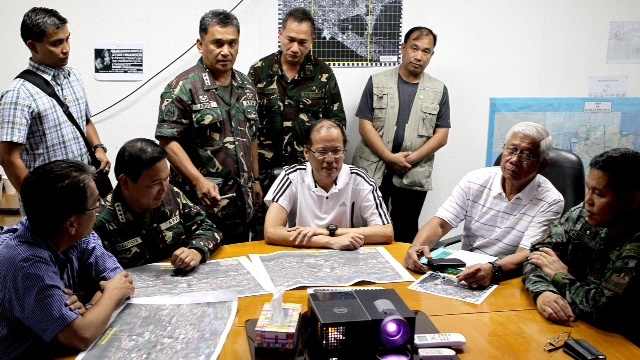 COMMAND CONFERENCE: President Aquino meeting with Secretaries Mar Roxas, Voltaire Gazmin, PNP Chief Alan Purisima, AFP Chief of Staff Gen. Emmanuel Bautista, Western Mindanao Command Commander Gen. Rey Ardo and members of the AFP at the height of the crisis in Zamboanga City. Malacañang Photo
COMMAND CONFERENCE: President Aquino meeting with Secretaries Mar Roxas, Voltaire Gazmin, PNP Chief Alan Purisima, AFP Chief of Staff Gen. Emmanuel Bautista, Western Mindanao Command Commander Gen. Rey Ardo and members of the AFP at the height of the crisis in Zamboanga City. Malacañang Photo
ZAMBOANGA CITY, Philippines — “What drama is this, Mr President?”
It was the night of Day 5, September 13, and the meeting between President Benigno Aquino III and Zamboanga City local officials and stakeholders was highly charged.
Zamboangeños were frustrated that the standoff was taking too long.
“Who is really in control?” asked another.
President Aquino tried to calm them. He stressed that the situation is under control. It’s only 5 out of 98 barangays under siege. They’re not “isolated” just because air travels were cancelled. Land travels were still allowed.
The President’s statement echoed earlier statements by Department of the Interior and Local Government (DILG) Secretary Manuel “Mar” Roxas II that only “a very, very small portion of Zamboanga” is affected by conflict.
One frustrated councilor felt the ground commanders downplayed the situation to the President, who arrived in the city that day.
Officials from Manila observing the meeting felt the Zamboangeños were very disrespectful of the President.
The very tense meeting on Day 5 gives a glimpse of how the crisis was managed and the challenges they faced. There was no clear leader before the President arrived. The Zamboangeños were also very suspicious of the national government.
Zamboangeños wanted swift military action
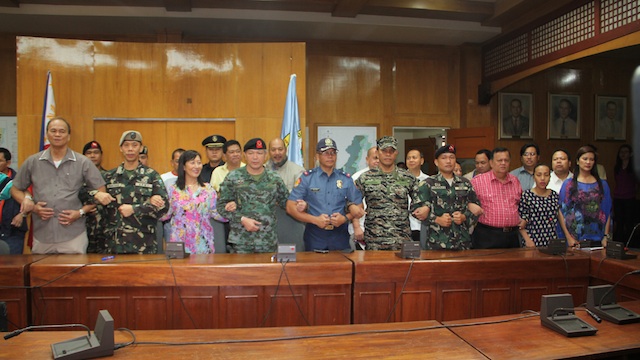 CONGRESSIONAL INQUIRY: The Zamboanga City Council is asking for a Senate inquiry on the crisis. Photo courtesy of the Zamboanga City government
CONGRESSIONAL INQUIRY: The Zamboanga City Council is asking for a Senate inquiry on the crisis. Photo courtesy of the Zamboanga City government
Councilor Rogelio Velasco Jr could not understand how it could happen to Zamboanga City.
"The very ironic question is: How come these things happen in Zamboanga? We have the Western Mindanao Command (Westmincom). We have the regional police command. We have the naval and the air base. These are the questions the people of Zamboanga are asking our authorities," he told Rappler on Day 6 of the crisis.
Even the US military has a facility inside the Westmincom.
Police investigation now shows that the MNLF started sneaking firearms into Zamboanga City as early as January.
Ironically, Mayor Maria Isabelle "Beng" Climaco-Salazar is married to the chief of the National Intelligence Coordinating Agency (NICA), retired Major Gen Trifonio Salazar. But the agency has been dismissed as a mere coordinator of intelligence efforts, largely dependent on field work by the police and the military.
Not a few Zamboangeños wanted swift military action to end the crisis. “That’s the only option, maybe. It is also the clamor of the people of Zamboanga,” said Zamboanga City Rep Lilia Nuño a day after the meeting.
“If it will still drag on, the scenario will be worse. There might be looting because people are already hungry. This is the thing that we are preventing,” Nuño told Rappler then.
When a full-blown military assault was discussed during the Friday night meeting, the President asked, “Do you understand what you are talking about? Can you attend the funeral of 300?”
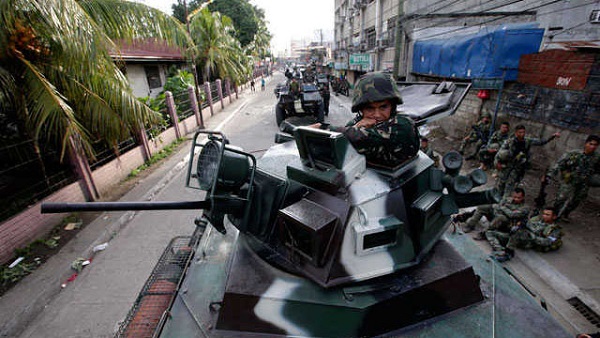 MILITARY ZONE. Soldiers in Zamboanga City. Photo by EPA
MILITARY ZONE. Soldiers in Zamboanga City. Photo by EPA
The military started advancing against the Moro National Liberation Front (MNLF) fighters a few hours before the Friday night meeting — shifting its approach from “containment” to “calibrated response.” The following day, Saturday morning, was when the military used for the first time heavy-powered firearms.
Salazar also announced she wanted it over that day, September 14, Day 6 of the crisis.
“The way I see it, it’s already an assault,” Nuño told Rappler. Two days later, on Day 8 of the crisis, Alert Level 4 was raised, meaning the situation demanded the President’s attention.
The standoff dragged until the 20th day because, according to the military, the President’s instruction was to make sure all the hostages were safe.
Even as the military eventually launched air strikes, the President's instructions meant they couldn’t use the full arsenal of the military to quash the MNLF.
Looking back, Salazar said it was "God's perfect timing."
Mayor’s non-negotiable
Salazar pursued negotiations with the MNLF. She even spoke
with MNLF founder Nur Misuari and Commander Habier Malik on the phone.
“Yes. Negotiations took place. Negotiations were exhausted to the best we can. At the end of the day, what they sought was the return and full implementation of the final peace accord. It is not within my level as city mayor,” Salazar told Rappler in an interview.
There was an opportunity to peacefully end the crisis during the early stages of the standoff. Malik offered to release all hostages on condition they would be given a “safe conduct pass” so they could return to the negotiating table.
Malik wanted to repeat what happened 12 years ago when the MNLF pulled the same stunt in Zamboanga City’s barangay’s Cabatangan. The city allowed the MNLF a “safe conduct pass” and they were forced to literally watch the rebels walk away — on live TV — in exchange for the safety of the hostages.
On September 9, the rebels were back. Zamboangeños expected the two-month mayor to make sure the rebels wouldn't repeat Cabatangan.
Salazar often cried in press briefings in the early days of the crisis. But as easily as tears welled up in her eyes, she would quickly straighten up to show her firm resolve that Malik and his men should be punished.
Salazar made this clear to the generals. This was her non-negotiable and she would repeat her message over and over.
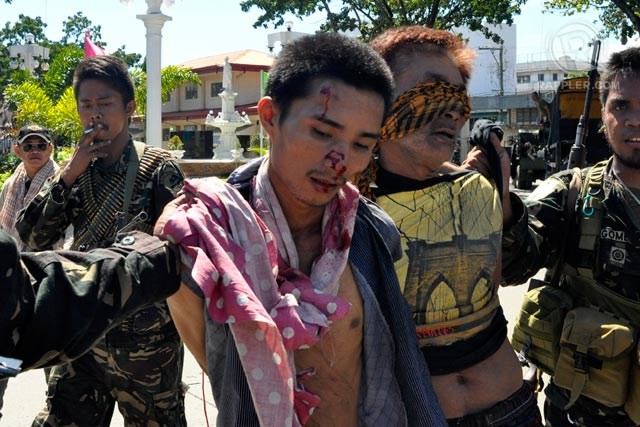 ARRESTED: Military arrests 2 MNLF fighters on Day 8 of crisis. Photo by LeAnne Jazul
ARRESTED: Military arrests 2 MNLF fighters on Day 8 of crisis. Photo by LeAnne Jazul
Negotiation
Among those who offered to help in the negotiation as early as Day 1 is the Sulu-based Bantay Bayanihan, the military's own multi-sectoral program to combat insurgency and rebellion.
Grace Jimeno Rebollos, the regional Bantay Bayanihan convener for western Mindanao, lamented the hardline position of Salazar against a Cabatangan solution.
“Not wanting a Cabatangan was a constant mantra. Yet the lives of civilian hostages figured much in the dilemma,” said Rebollos. It would have diminished destruction to life and property, and limited the number of internally displaced persons.
Hostaged Catholic priest Fr Michael Ufana also pushed for the Cabatangan solution. It’s the only way to make sure the hostages are safe, he said.
What government can do to seek justice is hunt down Malik and his men when they have left Zamboanga City, the priest argued.
But Salazar stuck to her guns.
[Video: Zambo Mayo Beng Climaco's non-negotiable http://www.youtube.com/watch?v=K8dlfvCTfVE]
The issue is also deeper than Cabatangan.
Zamboangeños see both 2001 Cabatangan siege and the September 9 attack against the backdrop of the 1976 Tripoli Agreement signed by the Marcos government with the MNLF, which aims to include Zamboanga City among 13 provinces to form the autonomous region. The city repeatedly voted against it in plebiscites.
MNLF hoisting their flag at the City Hall was simply unacceptable.
Rebollos also slammed the “refusal” of their military partners to entertain their efforts during the crisis.
“Amidst the burning of houses, our interlocutors were in no mood to meet us, and even exhorted us to 'forget Bantay Bayanihan,'” Rebollos said.
“When push comes to shove, the military will exercise what it does best — fire the gun ostensibly under the orders of the commander-in-chief,” she added.
[Video: After addressing 'spoliers,' AFP chief looks forward to peace pact with MILF
Armed Forces Chief of Staff Gen Emmanuel Bautista said the military option was the final option.
“The military was not the one leading the crisis management
committee. Unlike in the past, the military commander was at the forefront.
Civil authorities were at the forefront. We were just part of the crisis
management committee," Bautista said.
It was the "concern for hostages" that
"delayed the resolution of the crisis," said Bautista.
"By any standards, I think that is a good accomplishment on the part of the mltiary," Bautista said.
OPAPP’s mistake
OPAPP’s mistake
Salazar, for her part, highlighted the role that should have been played by the Office of the Presidential Adviser on the Peace Process (OPAPP).
The OPAPP has been criticized for its failure to properly communicate with the MNLF that it will not be sidetracked by the ongoing peace negotiations with its rival group, the Moro Islamic Liberation Front (MILF).
It's the biggest lesson of the crisis, she said. "We have to listen to the diverse voices in Mindanao to dialogue and empathize because it will mean so much in the greater development of her and his story of the children of Mindanao. It pays to listen. If we did not listen, we pay big and pay big time," she added.
Malik protested the peace deal between the government and the MILF. To him, the peace deal with the MILF would supersede the peace pact with the MNLF.
But the government said the MNLF is, in fact, invited to join the
talks for the creation of the Bangsamoro being discussed at present with the
MILF. MNLF personalities may even run to lead the new Bangsamoro entity.
Malik’s former hostage, former Marine Gen Benjamin Dolorfino, also
talked about the OPAPP’s shortcomings in communicating this. He talked about a
conversation with OPAPP officials when he warned about a “possible violent
repercussion” if it is not explained well.
“He (OPAPP official) told me the government considers the MNLF a spent force. See what happened?” Dolorfino said.
Dolorfino said the reason that led Malik to hostage him in 2007 is the same reason that led him to attack Zamboanga City — the failure of the Tripartite Review to take off.
"The MNLF has so much expectation out of the Tripartite Review. By denying them this venue, they have no other recourse but look for other means to ventilate their position," Dolorfino said.
OPAPP Undersecretary Jose Lorena doesn't believe the siege was triggered by the talks with MILF.
[Video: Understanding Misuari's motivations
"I hate to say this but perhaps Chairman Misuari is already an old man and perhaps he would like to end something with him there in the picture, which is definitely wrong because causing all these is wrong," Lorena said.
"He was just perhaps jealous of something. He always
said, 'I am the founding chairman of the MNLF. These people are just my junior
including the new leadership of the MILF.' It's the thought that he cannot
readily accept. The process of the MILF and the MNLF are just what we call
complementation," Lorena added.
Staged war?
As the standoff dragged, Zamboangeños entertained ideas of a staged war.
Staged war?
As the standoff dragged, Zamboangeños entertained ideas of a staged war.
There’s also talk about the 2016 presidential elections, especially because the crisis involved presumed presidential candidates DILG Secretary Roxas and at one point Vice President Jejomar Binay.
Speculations abounded when Zamboanga City police chief Senior Supt Chiquito Malayo was taken hostage by the MNLF but was able to turn around the situation and instead make 23 MNLF fighters surrender.
At least one local radio station commentator lengthily talked about a supposed "game of the generals." It was not uncommon to hear residents — rich and poor — echo the speculations.
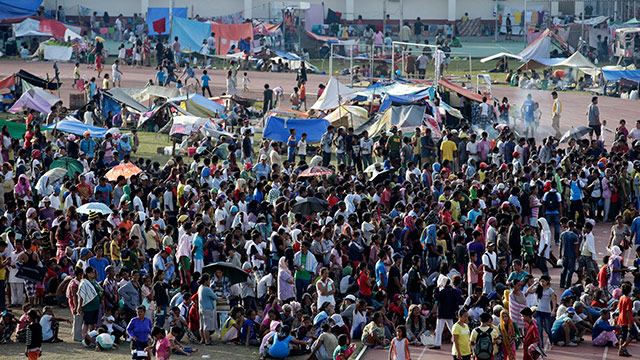 WAITING. Evacuees wait for food supplies inside a football stadium turned into a temporary shelter. Photo by Dennis Sabangan/EPA
WAITING. Evacuees wait for food supplies inside a football stadium turned into a temporary shelter. Photo by Dennis Sabangan/EPA
How can this be explained, Rappler asked Salazar. “Precisely, this encroachment of fear — misinformation of text messages and of sightings — are what causes these rumblings in the heart. It makes the pain, anger and frustration that we would have wanted to go back to normalcy,” Salazar said.
Social media didn’t help. The picture of a Muslim youth leader circulated in the social media and he was accused of organizing young people to reinforce Malik and his men. He eventually faced the media to correct the misconception.
What is being whispered about in Zamboaga City eventually reached Manila. Sen Miriam Santiago accused her political enemy Sen Juan Ponce Enrile, currently embroiled in the alleged pork barrel scam, as the man behind the MNLF attack. It’s supposed to divert national attention from the pork scam to the Zamboanga crisis.
Even former soldiers, Magdalo representatives Ashley Acedillo and Gary Alejano, joined the loose talk.
More questions
On September 28, the crisis was declared over although there
were still sporadic firefights between government forces and
"remnant" MNLF fighters hiding in houses.
Military statistics show among those killed were 183 MNLF fighters, 18 soldiers, 5 cops, and 12 civilians. A total of 195 hostages were rescued and 292 MNLF fighters either surrendered or were captured.
Over 10,000 houses were damaged by fires and over 100,000 Zamboangeños are staying in evacuation centers and will stay there for months until the city government has rehabilitated the combat zone.
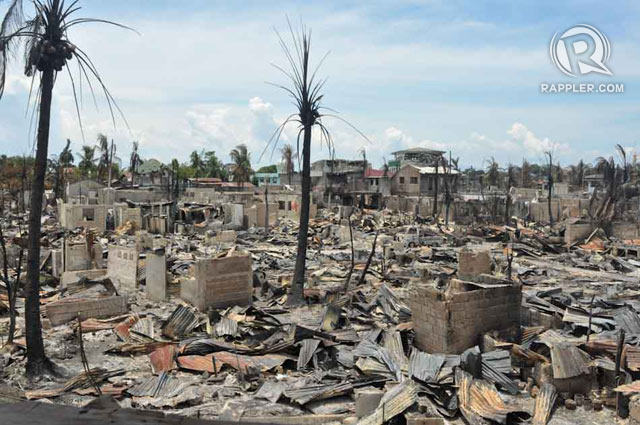 BURNED: More than 10,000 houses were damaged by fires inside the combat zone. Photo by LeAnne Jazul
BURNED: More than 10,000 houses were damaged by fires inside the combat zone. Photo by LeAnne Jazul
Aquino is confident the MNLF has been diminished and could not launch another attack against Zamboanga City. Cases have been filed against the MNLF fighters in custody and MNLF's Misuari.
Malik could not be found, however. Government troops are determining if he is among the dead bodies recovered. It's not an easy process, supposedly, because some cadavers are in advance stages of decay. Either that, or he has escaped.
But there are a lot of questions waiting to be answered. There are those who ask: Why do fires break out when the crisis is already over? It’s reminiscent of the "Burning of Sulu" where the military was accused of burning the city to flush out the Muslim separatists.
The Zamboanga City Council has also sought a congressional probe to explain what happened in the city.
Salazar also laments hostages blaming her for "abandoning" them. "We empathize with the people. There will be a greater processing that will take place. And that begins with me," Salazar added.
The war is over but the fog remains.

No comments:
Post a Comment
Note: Only a member of this blog may post a comment.